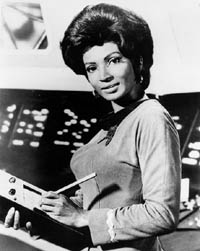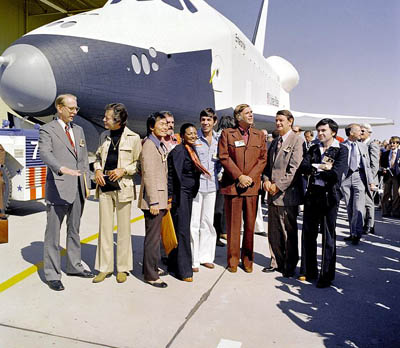“Space: the final frontier. These are the voyages of the starship Enterprise. Its five-year mission: to explore strange new worlds, to seek out new life and new civilizations; to boldly go where no man has gone before.” – Introduction to each episode of the original Star Trek series
 USS Enterprise model used in the original Star Trek series Credit: Shannon Lucas |
Many of us will remember the Bush years as the administration under which Star Trek: Enterprise went off the air, an brief dark age when it appeared there would be no Star Trek on the air again for a very long time. Now we have Barack “Hope” Obama as President, and, with his administration, a brand new Star Trek movie, 43 years after the show first aired. The original Star Trek was a grass-roots phenomena, only able to stay on the air for a second and third season because of an unprecedented letter-writing campaign by its fans. The show thrived in syndication, leading to six television series totaling 716 episodes across 30 seasons, 70 million books in print, 40 video games, and this week’s release will mark its 11th feature film.
 Nichelle Nichols, NASA Recruiter Credit: NASA |
Highly progressive philosophically, Star Trek portrayed a future of world peace for Earth, a united human race venturing amongst the stars. The cast was ethnically diverse, with one of the first major African American characters on an American television series in Chief Communications Officer Uhura, whose name comes from the Swahili word for “freedom,” and who came from the “United States of Africa.1” Nichelle Nichols, who played Uhura, was persuaded by Martin Luther King Jr. to stay on the show as a role model for the black community when she considered quiting after the first season.
In addition to Uhura, Star Trek included the first positive portrayal of a Japanese character in helmsman Sulu. In the midst of the Cold War, the show featured the Russian ensign Chekov on the bridge. The Scottish Engineer Scotty and country doctor Leonard McCoy rounded out the cast’s cultural diversity.
The show tackled social issues, like slavery and religious freedom in Bread and Circuses, where the crew encounter a planet similar to ancient Rome, complete with oppressed Christians. The episode Let That Be Your Last Battlefield, where the Enterprise picks up the last two survivors of a war torn planet, each half black and half white, but their colors on opposite sides of their faces, deals with the insane senselessness of racial discrimination. In numerous episodes, America’s cold war with Russia and the war in Vietnam were alluded to in the Enterprise’s encounters with Klingons and Romulans.
With a firm historical, moral, and intellectual grounding in its storytelling, Star Trek was able to become one of the most culturally influential television shows in history. The fans were able to convince NASA to name the first space shuttle orbiter after the USS Enterprise.
 Cast of Star Trek in front of the Space Shuttle Enterprise Credit: NASA |
In the episode Who Mourns for Adonais? the crew encounters Apollo, last survivor of a band of space travelers who inspired the Greek gods. This is a theme reflected in numerous Star Trek episodes, as with the Organians in Errand of Mercy, Vaal in The Apple, and the Metrons in Arena. Aliens with godlike powers resembles Michael Shermer’s spin on Clarke’s Third Law, “Any sufficiently advanced Extra-Terrestrial Intelligence is indistinguishable from God.”
Star Trek offers the possibility of a similar future to the human race. The show has stood out and remained strong these four decades because of its positive message and vision. With their incredibly advanced technologies and their strong moral character, the crew of the Enterprise are role models for a human race. The documentary Trekkies reveals a fan base comprised of geeks and nerds, but they are also scientists, inventors, and doctors. The USS Enterprise’s name follows a long history of over 26 real-life ships from the HMS Enterprise (1709-1749) to the 1961 Aircraft Carrier USS Enterprise (CVN-65) to the 1976 Space Shuttle Enterprise and soon the VSS Enterprise Virgin Galactic’s first commercial spacecraft. The course of human history is one of incredible social and technological improvement, we are reaching further into the stars, where we have Star Trek’s visionary outlook to guide us.
“As the right of each sentient species to live in accordance with its normal cultural evolution is considered sacred, no Starfleet personnel may interfere with the normal and healthy development of alien life and culture. Such interference includes introducing superior knowledge, strength, or technology to a world whose society is incapable of handling such advantages wisely. Starfleet personnel may not violate this Prime Directive, even to save their lives and/or their ship, unless they are acting to right an earlier violation or an accidental contamination of said culture. This directive takes precedence over any and all other considerations, and carries with it the highest moral obligation.”
1 The original pilot for Star Trek included a woman in the role of second-in-command, but network executives at NBC demanded she be cut from the show. Despite the show’s progressive vision, the mini-skirts and secretarial positions women filled in the show have always been an unfortunate part of its history, and not part of Gene Roddenberry’s original vision. Later spin-off shows would put women and other ethnicities in leadership positions.
Comments
3 responses to “42 More Years of Star Trek”